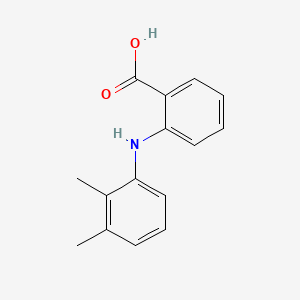m6A-centered Drug Response Information
General Information of the Drug (ID: M6APDG01514)
| Name |
Mefenamic acid
|
||||
|---|---|---|---|---|---|
| Synonyms |
ApoMefenamic; Bonabol; Contraflam; Coslan; Dysman; Lysalgo; Mefac; Mefacit; Mefedolo; Mefenacid;Mefenamate; Mefenaminsaeure; Mefic; Mycasaal; Namphen; NuMefenamic; Parkemed; Pinalgesic; Ponalar; Ponalgic; Ponmel; Ponstan; Ponstel; Ponstil; Ponstyl; Ponsyl; Pontal; Rolan; Tanston; Vialidon; APS Brand of Mefenamic Acid; Acide mefenamique; Acide mefenamique [French]; Acido mefenamico; Acidum mefenamicum; Antigen Brand of Mefenamic Acid; Apo Mefenamic; Apotex Brand of Mefenamic Acid; Ashbourne Brand of Mefenamic Acid; Chemidex Brand of Mefenamic Acid; Clonmel Brand of Mefenamic Acid; Elan Brand of Mefenamic Acid; Farmasierra Brand of Mefenamic Acid; First Horizon Brand of Mefenamic Acid; Godecke Brand of Mefenamic Acid; Mefanamic acid; Mefenaminic Acid; Mefenaminsaeure [German]; Mephenamic acid; Mephenaminic acid; Methenamic acid; Nu Mefenamic; Nu Pharm Brand of Mefenamic Acid; PMS Mefenamic Acid; Parke Davis Brand of Mefenamic Acid; Pfizer Brand of Mefenamic Acid; Pharmascience Brand of Mefenamic Acid; Pinewood Brand of Mefenamic Acid; Ponstan forte; Rowa Brand of Mefenamic Acid; Tamany Bonsan; Warner Lambert Brand of Mefenamic Acid; CL 473; CN 35355; HL 1; ID8; INF 3355; M1782; AGN-1255; Ac. mefenamico; Ac. mefenamico [Italian]; Acid, Mefenamic; Acid, Mefenaminic; Acide mefenamique [INN-French]; Acido mefenamico [INN-Spanish]; Acidum mefenamicum [INN-Latin]; Apo-Mefenamic; Bafameritin-M; Bafhameritin-M; CN-35355; Dyfenamic (TN); F0850-6853; Forte, Ponstan; INF-3355; In-M; Mafepain (TN); Meftal (TN); Mephadolor (TN); Nu-Mefenamic; Nu-Pharm Brand of Mefenamic Acid; PMS-Mefenamic Acid; Parkemed (TN); Ponstal (TN); Ponstan (TN); Ponstel (TN); Potarlon (TN); Warner-Lambert Brand of Mefenamic Acid; Mefenamic acid (JP15/USP/INN); Mefenamic acid [USAN:INN:BAN:JAN]; N-2,3-Xylylanthranilic acid; N-(2,3-Dimethylphenyl)anthranilic acid; N-(2,3-Xylyl)anthranilic acid; N-(2,3-Xylyl)-2-aminobenzoic acid; 2-((2,3-Dimethylphenyl)amino)benzoic acid; 2-(2,3-Dimethylanilino)benzoic acid; 2-(2,3-Xylidino)benzoic Acid; 2-(2,3-dimethylphenylamino)benzoic acid; 2-[(2,3-dimethylphenyl)amino]benzoic acid
Click to Show/Hide
|
||||
| Status |
Approved
|
||||
| Structure |
 |
||||
| Formula |
C15H15NO2
|
||||
| InChI |
1S/C15H15NO2/c1-10-6-5-9-13(11(10)2)16-14-8-4-3-7-12(14)15(17)18/h3-9,16H,1-2H3,(H,17,18)
|
||||
| InChIKey |
HYYBABOKPJLUIN-UHFFFAOYSA-N
|
||||
| PubChem CID | |||||
| TTD Drug ID | |||||
| INTEDE Drug ID | |||||
Target Gene(s) and Their Upstream m6A Regulator, Together with the Effect of Target Gene(s) in Drug Response
The target genes involved in drug-target interaction (such as drug-metabolizing enzymes, drug transporters and therapeutic targets) and drug-mediated cell death signaling (including modulating DNA damage and repair capacity, escaping from drug-induced apoptosis, autophagy, cellular metabolic reprogramming, oncogenic bypass signaling, cell microenvironment, cell stemness, etc.) could be regulated by m6A regulator(s) and affected their corresponding drug response. You can browse detailed information on drug-related target gene(s) mediated by m6A regulators.
Cytochrome P450 2C8 (CYP2C8)
Fat mass and obesity-associated protein (FTO)
| In total 1 mechanisms lead to this potential drug response | ||||
| Response Summary | Cytochrome P450 2C8 (CYP2C8) is a therapeutic target for Mefenamic acid. The Fat mass and obesity-associated protein (FTO) has potential in affecting the response of Mefenamic acid through regulating the expression of Cytochrome P450 2C8 (CYP2C8). | [1], [2] | ||
Methyltransferase-like 14 (METTL14)
| In total 1 mechanisms lead to this potential drug response | ||||
| Response Summary | Cytochrome P450 2C8 (CYP2C8) is a therapeutic target for Mefenamic acid. The Methyltransferase-like 14 (METTL14) has potential in affecting the response of Mefenamic acid through regulating the expression of Cytochrome P450 2C8 (CYP2C8). | [1], [2] | ||
Methyltransferase-like 3 (METTL3)
| In total 1 mechanisms lead to this potential drug response | ||||
| Response Summary | Cytochrome P450 2C8 (CYP2C8) is a therapeutic target for Mefenamic acid. The Methyltransferase-like 3 (METTL3) has potential in affecting the response of Mefenamic acid through regulating the expression of Cytochrome P450 2C8 (CYP2C8). | [1], [2] | ||
YTH domain-containing protein 2 (YTHDC2)
| In total 1 mechanisms lead to this potential drug response | ||||
| Response Summary | Cytochrome P450 2C8 (CYP2C8) is a therapeutic target for Mefenamic acid. The YTH domain-containing protein 2 (YTHDC2) has potential in affecting the response of Mefenamic acid through regulating the expression of Cytochrome P450 2C8 (CYP2C8). | [1], [2] | ||
Prostaglandin G/H synthase 2 (COX-2)
Methyltransferase-like 3 (METTL3)
| In total 1 mechanisms lead to this potential drug response | ||||
| Response Summary | Prostaglandin G/H synthase 2 (COX-2) is a therapeutic target for Mefenamic acid. The Methyltransferase-like 3 (METTL3) has potential in affecting the response of Mefenamic acid through regulating the expression of Prostaglandin G/H synthase 2 (COX-2). | [3], [4] | ||
References